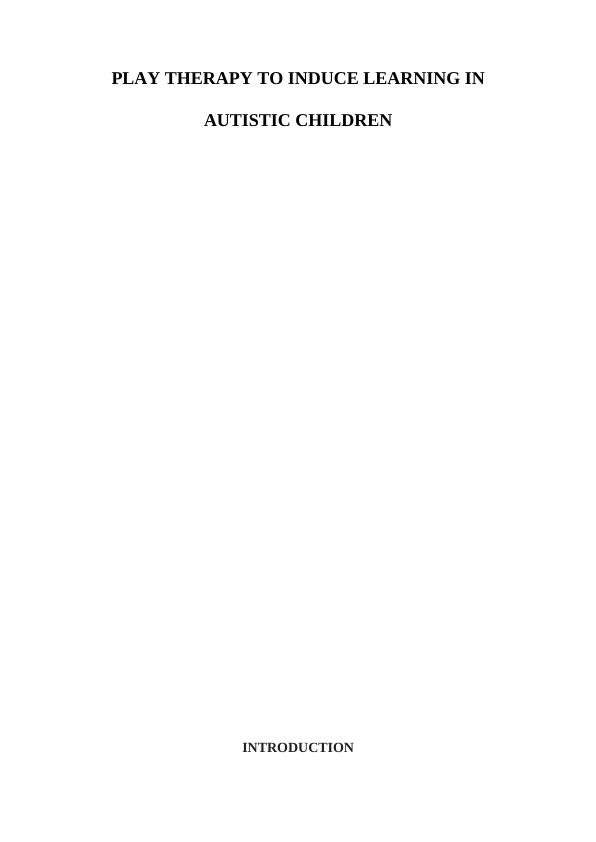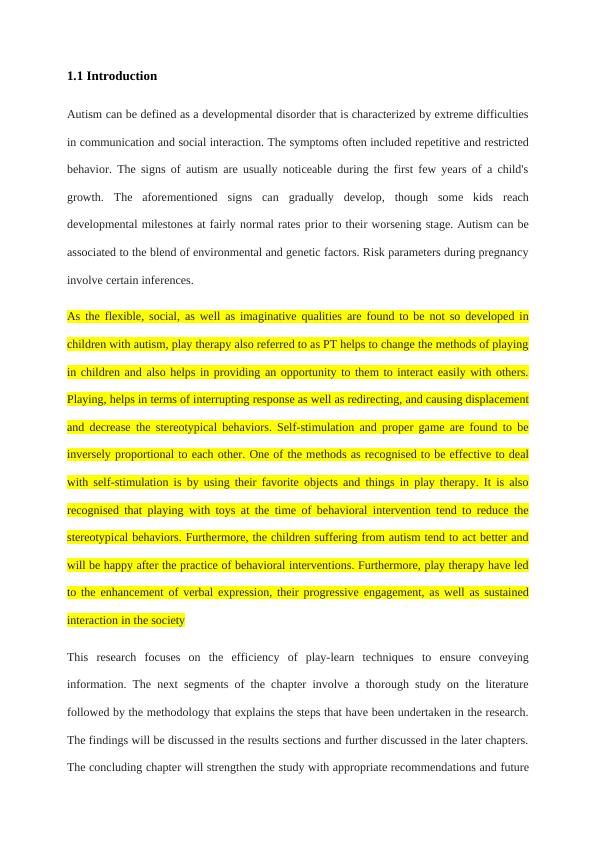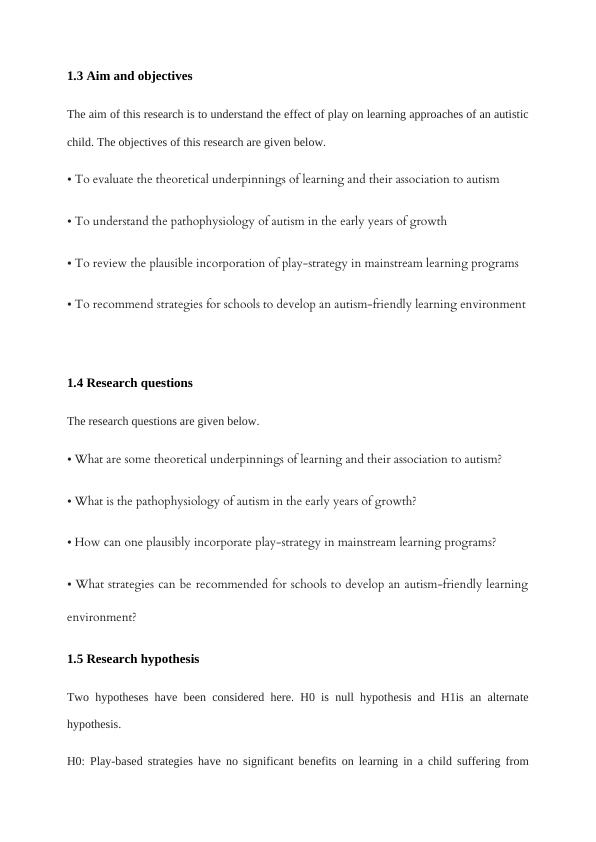Play Therapy to Induce Learning in Autistic Children
Added on 2023-01-23
13 Pages3406 Words52 Views
PLAY THERAPY TO INDUCE LEARNING IN
AUTISTIC CHILDREN
INTRODUCTION
AUTISTIC CHILDREN
INTRODUCTION

1.1 Introduction
Autism can be defined as a developmental disorder that is characterized by extreme difficulties
in communication and social interaction. The symptoms often included repetitive and restricted
behavior. The signs of autism are usually noticeable during the first few years of a child's
growth. The aforementioned signs can gradually develop, though some kids reach
developmental milestones at fairly normal rates prior to their worsening stage. Autism can be
associated to the blend of environmental and genetic factors. Risk parameters during pregnancy
involve certain inferences.
As the flexible, social, as well as imaginative qualities are found to be not so developed in
children with autism, play therapy also referred to as PT helps to change the methods of playing
in children and also helps in providing an opportunity to them to interact easily with others.
Playing, helps in terms of interrupting response as well as redirecting, and causing displacement
and decrease the stereotypical behaviors. Self-stimulation and proper game are found to be
inversely proportional to each other. One of the methods as recognised to be effective to deal
with self-stimulation is by using their favorite objects and things in play therapy. It is also
recognised that playing with toys at the time of behavioral intervention tend to reduce the
stereotypical behaviors. Furthermore, the children suffering from autism tend to act better and
will be happy after the practice of behavioral interventions. Furthermore, play therapy have led
to the enhancement of verbal expression, their progressive engagement, as well as sustained
interaction in the society
This research focuses on the efficiency of play-learn techniques to ensure conveying
information. The next segments of the chapter involve a thorough study on the literature
followed by the methodology that explains the steps that have been undertaken in the research.
The findings will be discussed in the results sections and further discussed in the later chapters.
The concluding chapter will strengthen the study with appropriate recommendations and future
Autism can be defined as a developmental disorder that is characterized by extreme difficulties
in communication and social interaction. The symptoms often included repetitive and restricted
behavior. The signs of autism are usually noticeable during the first few years of a child's
growth. The aforementioned signs can gradually develop, though some kids reach
developmental milestones at fairly normal rates prior to their worsening stage. Autism can be
associated to the blend of environmental and genetic factors. Risk parameters during pregnancy
involve certain inferences.
As the flexible, social, as well as imaginative qualities are found to be not so developed in
children with autism, play therapy also referred to as PT helps to change the methods of playing
in children and also helps in providing an opportunity to them to interact easily with others.
Playing, helps in terms of interrupting response as well as redirecting, and causing displacement
and decrease the stereotypical behaviors. Self-stimulation and proper game are found to be
inversely proportional to each other. One of the methods as recognised to be effective to deal
with self-stimulation is by using their favorite objects and things in play therapy. It is also
recognised that playing with toys at the time of behavioral intervention tend to reduce the
stereotypical behaviors. Furthermore, the children suffering from autism tend to act better and
will be happy after the practice of behavioral interventions. Furthermore, play therapy have led
to the enhancement of verbal expression, their progressive engagement, as well as sustained
interaction in the society
This research focuses on the efficiency of play-learn techniques to ensure conveying
information. The next segments of the chapter involve a thorough study on the literature
followed by the methodology that explains the steps that have been undertaken in the research.
The findings will be discussed in the results sections and further discussed in the later chapters.
The concluding chapter will strengthen the study with appropriate recommendations and future

scope.
1.2 Background
Play therapy is conceived as an equipment to provide psychotherapy to the young learners who
have been coping with anxiety, trauma and other mental illness. In the context of autism, play
therapy is a mannerism for the children to be aware of their needs and deduce appropriate
coping mechanisms. As opined by Banire, Jomhari and Ahmad (2015), play therapy is not
similar in application for mental illness and learning disabilities. Specialists offering play
therapy through providing Floortime Therapy. It is a common play-based approach that drives
the interests of autistic children to develop healthy communication and social relationships.
Autism is derived from a large category of social-communication disability. Children suffering
from autism can find difficulties to associate to people in typical mannerism. Play therapy can
be an influential approach to aid learners to move implement self-absorption in real time and
shared interactions. In case of appropriate application, this therapy can allow autistic children to
discover their environment, feelings and relationships with their peers. Hence, it can be
discussed that conventional learning programs must take into consideration of a learning
therapy that can aid autistic children to take a focal role in their own growth and development.
Play therapy must be taught to teachers and parents, to incorporate it in the daily regime of their
autistic child. As a result, it can build a positive and stronger relationship. This may include the
care to engage with the child through a medium of informal play. For instance, teachers may set
out multiple toys that can raise interest in the child. Chahboun et al. (2016) comment this may
cater to the development of decision-making skills of the autistic child as per their own
preferences. Overdue time, teachers may work alongside the autistic child to formulate
reciprocal skills, such as turn-taking, sharing. It may also involve abstract thinking and
imaginative skills. With gradual development, the child gets better in formulating relational
skills with other learners in the group.
1.2 Background
Play therapy is conceived as an equipment to provide psychotherapy to the young learners who
have been coping with anxiety, trauma and other mental illness. In the context of autism, play
therapy is a mannerism for the children to be aware of their needs and deduce appropriate
coping mechanisms. As opined by Banire, Jomhari and Ahmad (2015), play therapy is not
similar in application for mental illness and learning disabilities. Specialists offering play
therapy through providing Floortime Therapy. It is a common play-based approach that drives
the interests of autistic children to develop healthy communication and social relationships.
Autism is derived from a large category of social-communication disability. Children suffering
from autism can find difficulties to associate to people in typical mannerism. Play therapy can
be an influential approach to aid learners to move implement self-absorption in real time and
shared interactions. In case of appropriate application, this therapy can allow autistic children to
discover their environment, feelings and relationships with their peers. Hence, it can be
discussed that conventional learning programs must take into consideration of a learning
therapy that can aid autistic children to take a focal role in their own growth and development.
Play therapy must be taught to teachers and parents, to incorporate it in the daily regime of their
autistic child. As a result, it can build a positive and stronger relationship. This may include the
care to engage with the child through a medium of informal play. For instance, teachers may set
out multiple toys that can raise interest in the child. Chahboun et al. (2016) comment this may
cater to the development of decision-making skills of the autistic child as per their own
preferences. Overdue time, teachers may work alongside the autistic child to formulate
reciprocal skills, such as turn-taking, sharing. It may also involve abstract thinking and
imaginative skills. With gradual development, the child gets better in formulating relational
skills with other learners in the group.

1.3 Aim and objectives
The aim of this research is to understand the effect of play on learning approaches of an autistic
child. The objectives of this research are given below.
To evaluate the theoretical underpinnings of learning and their association to autism⦁
To understand the pathophysiology of autism in the early years of growth⦁
To review the plausible incorporation of play-strategy in mainstream learning programs⦁
To recommend strategies for schools to develop an autism-friendly learning environment⦁
1.4 Research questions
The research questions are given below.
What are some theoretical underpinnings of learning and their association to autism?⦁
What is the pathophysiology of autism in the early years of growth?⦁
How can one plausibly incorporate play-strategy in mainstream learning programs?⦁
What strategies can be recommended for schools to develop an autism-friendly learning⦁
environment?
1.5 Research hypothesis
Two hypotheses have been considered here. H0 is null hypothesis and H1is an alternate
hypothesis.
H0: Play-based strategies have no significant benefits on learning in a child suffering from
The aim of this research is to understand the effect of play on learning approaches of an autistic
child. The objectives of this research are given below.
To evaluate the theoretical underpinnings of learning and their association to autism⦁
To understand the pathophysiology of autism in the early years of growth⦁
To review the plausible incorporation of play-strategy in mainstream learning programs⦁
To recommend strategies for schools to develop an autism-friendly learning environment⦁
1.4 Research questions
The research questions are given below.
What are some theoretical underpinnings of learning and their association to autism?⦁
What is the pathophysiology of autism in the early years of growth?⦁
How can one plausibly incorporate play-strategy in mainstream learning programs?⦁
What strategies can be recommended for schools to develop an autism-friendly learning⦁
environment?
1.5 Research hypothesis
Two hypotheses have been considered here. H0 is null hypothesis and H1is an alternate
hypothesis.
H0: Play-based strategies have no significant benefits on learning in a child suffering from

End of preview
Want to access all the pages? Upload your documents or become a member.
Related Documents
Solutions Regarding Autism and Prader-Willi Syndromelg...
|10
|1761
|130
Autism Spectrum Disorder Disease Analysislg...
|4
|814
|14
Autism and Learning Disability: Impact, Causes, and Strategieslg...
|9
|2322
|200
Language Acquisition - PDFlg...
|8
|2075
|104
Music Therapy for Children with Autism Spectrum Disorderlg...
|9
|2171
|465
ADHD and Autism: Causes, Ramifications, and Teaching Strategieslg...
|8
|1415
|299
